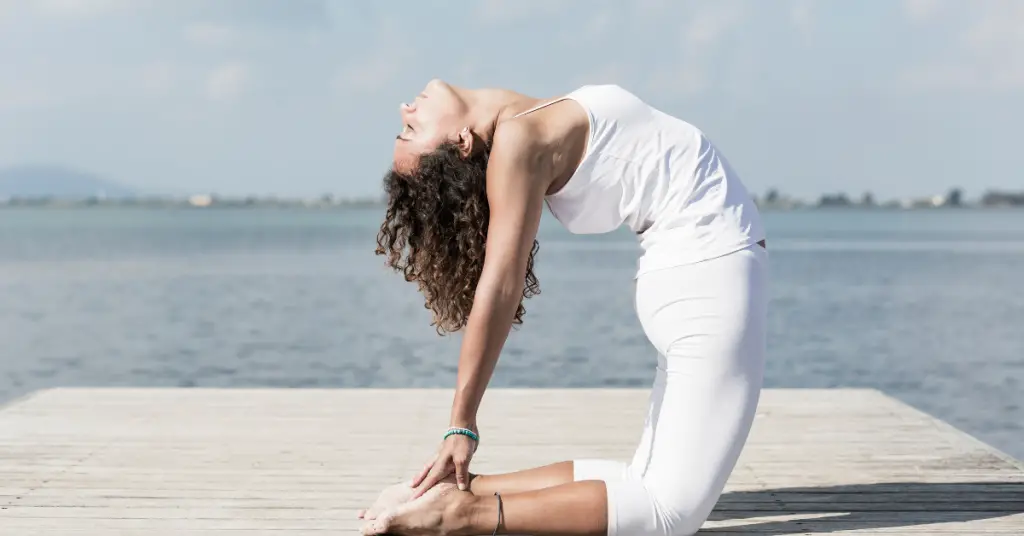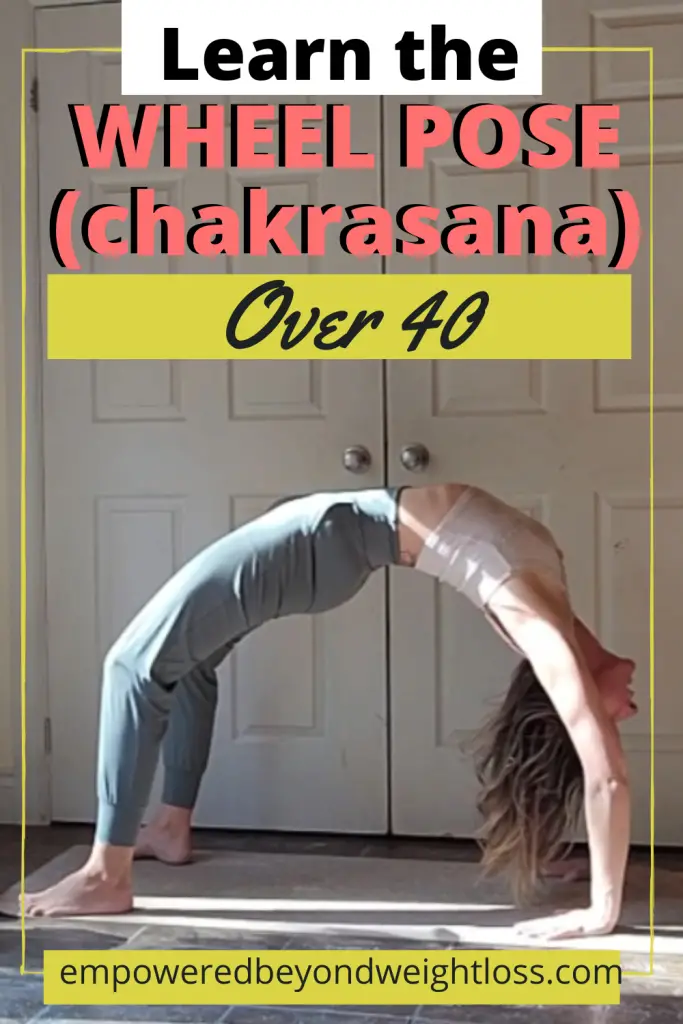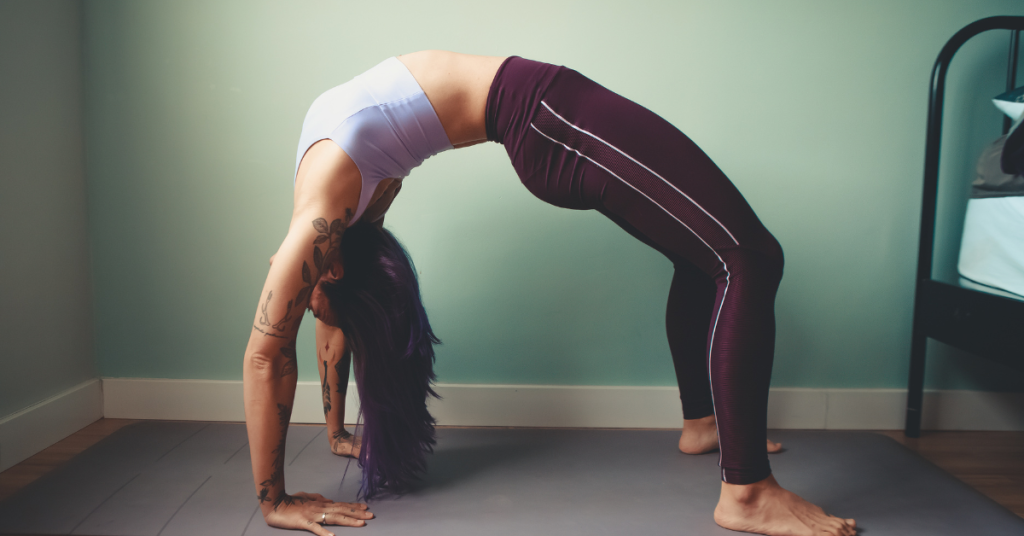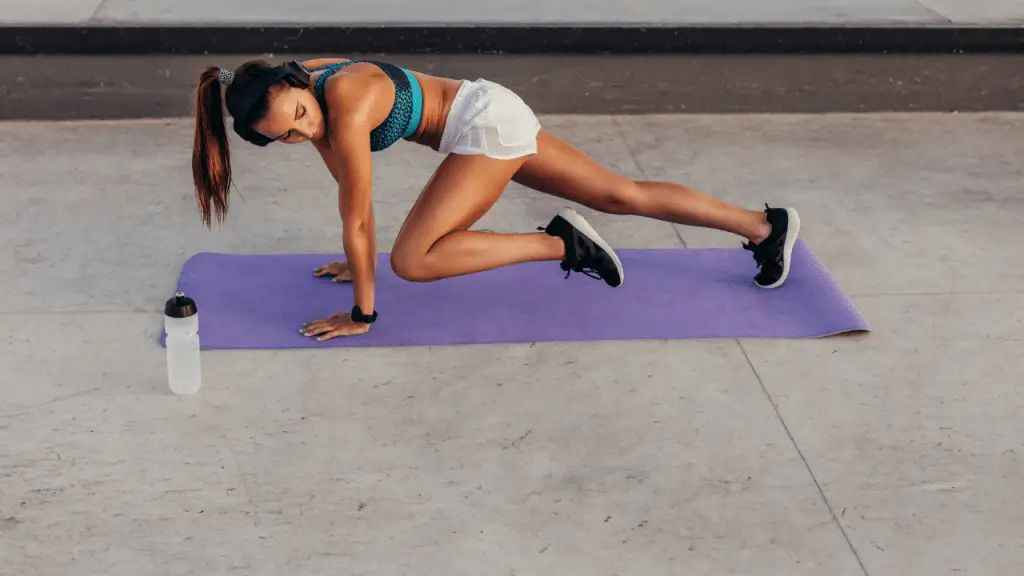I started doing yoga and working on my flexibility two years ago to learn the splits. In the process, I discovered the benefits of the wheel pose in yoga and so much more. I didn’t realize this was just the beginning of an incredible journey that would take me to places I would have never imagined. Today, I want to share those benefits and give you a full-length routine so you might feel motivated to get started and experience your transformation.
Benefits of the Wheel Pose in Yoga
The Wheel Pose, also known as Chakrasana or Urdhva Dhanurasana in yoga, offers several benefits for the body and mind. Here are some of the potential benefits. At first, the most apparent way Chakrasana benefits you is an immediate increase in energy (you will feel this with all backbends). Here are some of the main benefits of the wheel pose in yoga:
- Fewer aches and pain (because of your increased spinal flexibility and strength): The wheel Pose stretches and opens up the entire front body, including the chest, shoulders, and hip flexors. It helps improve spinal flexibility, making the spine more supple and agile. The pose also strengthens the back muscles, including the erector spine, which can contribute to better posture.
- Enhanced mobility and flexibility: Regular practice of Wheel Pose can improve overall body flexibility. It stretches and opens the shoulders, chest, abdomen, and hip flexors. As a result, it can enhance the range of motion in these areas and make everyday movements easier.
- Increased core strength: Wheel Pose engages the core muscles, including the abdominal, obliques, and lower back muscles. These muscles support and stabilize the body as you lift and maintain the pose. Regular practice can lead to a stronger core, essential for good posture and overall strength.
- Improved respiratory function: The deep backbend of Wheel Pose allows for a fuller expansion of the chest and lungs, promoting improved respiratory function. It encourages deep breathing, which can increase lung capacity and oxygen intake.
- Energizing and uplifting: Backbends like Wheel Pose can have an invigorating effect on the body and mind. They stimulate the nervous system, boost energy levels, and help alleviate feelings of fatigue or lethargy. Many practitioners find that practicing Wheel Pose can uplift their mood and create a sense of vitality.
- Heart-opening and emotional release: The wheel Pose is often described as a heart-opening pose. It helps to counteract the effects of rounded shoulders and poor posture by expanding the chest and opening the heart space. Some people experience emotional release and a sense of vulnerability during the pose, allowing for a release of tension and stored emotions.
- Stimulates the endocrine system: Backbends like Wheel Pose can stimulate the endocrine system, which regulates hormones in the body. This can positively impact various bodily functions, including metabolism, digestion, and hormonal balance.
- It’s cool! I don’t know about you, but I think learning the wheel as an adult, particularly as a mature adult is absolutely cool!
It’s important to note that while the Wheel Pose offers many potential benefits, it may not be suitable for everyone. If you have any pre-existing medical conditions or injuries, it’s advisable to consult with a qualified yoga instructor or healthcare professional before attempting this pose. They can guide modifications or alternative poses that may suit your needs.
How to Learn the Wheel Pose
I started working in the wheel pose when I was 43! No prior experience whatsoever! I was stiff and couldn’t even lift my head off the ground.
Here’s what I looked like:
Here’s how I get in the wheel pose now (in 2023):
Now you know what’s possible! Let’s discuss how to learn the wheel pose and enjoy all those benefits. But before we start, it helps to understand the mechanics behind the wheel pose. What are the muscles used in the wheel pose?
Want to learn about the step-by-step framework I used to work on my back and leg flexibility? Check out my Full-Body Flexibility Transformation.

Muscles Involved in the Wheel Pose in Yoga
Wheel Pose in yoga engages and works multiple muscle groups throughout the body. Here are the main muscles targeted during the pose:
- Back muscles: The primary muscles involved in Wheel Pose are the erector spinae, which run along the spine. These muscles help extend the spine and contribute to the backbend. The erector spinae is comprised of three groups: the iliocostalis, longissimus, and spinal muscles.
- Gluteal muscles: The gluteus maximus, the largest muscle in the buttocks, assists in extending the hips and provides stability during the pose.
- Quadriceps: The quadriceps muscles in the front of the thighs are actively engaged in Wheel Pose to help extend the knees and support the body’s weight.
- Hamstrings: The muscles at the back of the thighs, known as the hamstrings, are stretched and lengthened during the backbend of the Wheel Pose.
- Abdominal muscles: The rectus abdominis, commonly referred to as the “six-pack” muscles and the obliques are engaged to support the core and stabilize the body during the pose.
- Shoulders and chest muscles: The muscles of the shoulders and chest, including the deltoids, pectoralis major, and trapezius, play a crucial role in supporting and opening the chest and shoulders during Wheel Pose.
- Biceps and triceps: The muscles in the arms, particularly the biceps (front of the upper arm) and triceps (back of the upper arm), are involved in stabilizing and supporting the body’s weight.
It’s important to note that different individuals may experience variations in muscle engagement depending on their unique anatomy and alignment. Additionally, engaging the pelvic floor and deep core muscles can provide additional stability and support during the pose.

Poses to Prepare for the Wheel Pose
To prepare for the Wheel Pose (also known as Upward Bow Pose or Chakrasana), it’s beneficial to work on opening and strengthening specific areas of your body. Here are some yoga poses that can help you prepare for the Wheel Pose:
- Bridge Pose (Setu Bandhasana): This pose helps open the chest, stretch the hip flexors, and strengthen the glutes and hamstrings, which are essential for the Wheel Pose.
- Cobra Pose (Bhujangasana): The pose helps strengthen the back muscles, increase spinal flexibility, and open the chest, preparing you for the backbend of the Wheel Pose.
- Camel Pose (Ustrasana): Camel pose is a deep backbend that stretches the front of the body, opens the chest, and strengthens the back muscles, making it an excellent preparation for the Wheel Pose.
- Bow Pose (Dhanurasana): Bow pose stretches the front of the body, strengthens the back muscles, and improves spinal flexibility, all beneficial for the Wheel Pose.
- Upward-Facing Dog Pose (Urdhva Mukha Svanasana): This pose strengthens the arms, shoulders, and back while opening the chest, making it an excellent preparatory pose for the Wheel Pose.
- Sphinx Pose (Salamba Bhujangasana): The sphinx pose helps to gently open the chest and lengthen the spine, preparing you for deeper backbends like the Wheel Pose.
- Half Wheel Pose (Ardha Chakrasana): This modified version allows you to build strength and flexibility in your back and shoulders gradually.
Camel Pose Benefits
The camel pose is one of my all-time favorites to gain enough back strength and flexibility for the wheel pose. Watch my full-length videos to see some camel pose modifications.
Camel Pose (Ustrasana) offers several benefits:
- Stretches and opens the entire front of the body, including the chest, abdomen, and hip flexors.
- Increases spinal flexibility and helps improve posture.
- Strengthens the back muscles, particularly the erector spinae.
- Improves digestion and stimulates the abdominal organs.
- Enhances lung capacity and encourages deep breathing.
- Invigorates the nervous system and can help alleviate mild anxiety and fatigue.
- Promotes emotional release and can help cultivate self-confidence and self-expression.
- Stimulates the thyroid gland, which regulates metabolism.
- Improves circulation and energizes the body.
- Promotes a sense of openness, expansion, and balance.
- Can be beneficial for individuals with rounded shoulders or a hunched posture, as it helps to counteract the effects of sitting and slouching.

How to Learn the Wheel Pose Full-Length Video Routine
In Summary
The benefits of the wheel pose in yoga are all-encompassing: you will increase your physical strength, flexibility, and endurance, you will feel energized and confident, you will improve your posture, and you will move with more ease. Are you ready to get started?






